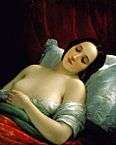Natale Schiavoni
Natale Schiavone (April 25, 1777 – April 15, 1858) was an Italian painter and engraver, mainly depicting history and portraits. Many of his paintings depict seductive nubile women.

Biography
Schiavoni was born in Chioggia, near Venice, and is claimed by Perkins to be a distant descendant of Andrea Schiavoni, the Venetian painter. In Venice, he trained with Francesco Maggiotto, and later came under the influence of the Neoclassicism.
He was peripatetic, traveling in 1800 to Trieste, and in 1810 to Milan, where he painted Eugene Beauharnais and the royal family. In Milan, he was able to frequent the studios of Appiani, Longhi, and Sabatelli.[1] In 1816, Schiavoni was invited by the Austrian emperor to Vienna, to become the official portratist for the court. From there, he returned to Venice in 1821, where he became professor at the Academy of Fine Arts. He resided in the Palazzo Giustinian on the Grand Canal.[2] He was awarded a gold medal at an exhibition in Brussels. Among his works are a Penitent Magdalene (1852) once on display in the National Gallery of Berlin; a painting on the same subject at the Vienna Museum; a Bacchante, once on display at the Stadel Gallery in Frankfort; and an Adoration of Shepherds, once on display at the British Museum, London.[3]
He was described by Pietro Selvatico as in coloring, highly skillful, but in shading, inimitably supreme.[4] He died in Venice.
His sons Felice (1803–68) and Giovanni (1804–48) were also painters of mythology and history.[5][6] Among his followers was Antonio Zuccaro (1815–1892).[7] Many of his paintings were engraved by Luigi Boscolo.
Gallery
-
.jpg)
Grand Duke Alexander Nikolaevich, 1838
-
.jpg)
Odalisque, 1845, Museo Revoltella, Trieste.
-

Dream of a Sixteen Year old, circa 1820.
-

The Sleeper, circa 1820.
References
- ↑ Istituto Matteucci, biography.
- ↑ Seeing Europe With Famous Authors (Complete) by Various.
- ↑ Cyclopedia of Painters and Paintings, Volume 4, by Charles Callahan Perkins, page 130.
- ↑ Natale e Felice Schiavoni, vita, opere, tempi, by Luigi G. Sernagiotto, Tipografia Municipal of Gaetano Longo, Venice (1881), page, Epigraph, in ogni parte del colorito valentissimo; ma nell'ombre poi inimitabilmente sommo.
- ↑ CC Perkins, page 130.
- ↑ Catalogue of the Masterpieces of Engraving and Etching Collected by the Late Late General Brayton Ives., by American Art Association Fourth Session, Tuesday Evening, April 13th.
- ↑ Museo Morpurgo, Ritratto di Fanciulla by Zuccaro.